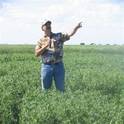Kenaf (Hibiscus cannabinus L.), mostly produced in China and India, is grown to a limited extent in the U.S., although this natural fiber can be a promising alternative to synthetic fibers for reinforcing plastic or other composite materials, or fuel purposes. Producing kenaf in the Midwestern U.S. could provide a local source of this fiber for use in a number of manufactured products and potentially for use as a biofuel feedstock. The objectives of this study were to: 1) compare the productivity and the morphology of kenaf cultivars ‘Tainung 2’ and ‘Whitten’ when grown in Iowa and Kentucky and harvested after the first killing frost; 2) assess kenaf growth over the growing season; and 3) determine management (variety and seed density) effects on kenaf productivity and morphology. In 2014 and 2015, varieties ‘Tainung 2’ and ‘Whitten’ were grown at 185300 and 370700 seed/ha in Iowa and in Kentucky. Stem and leaf biomass, plant population, core:bast ratio, stem height and diameter, leaf area index (LAI), and nitrogen concentration were measured during 6 in-season harvests and at the final harvest. Results showed that, ‘Tainung 2’ and ‘Whitten’ grown in Kentucky in 2014 yielded 24 and 19 Mg/ha, respectively, whereas both cultivars reached a final yield of 8 Mg/ha in Iowa. However, in 2015, final yields were similar for both locations (12.6 Mg/ha on average). It was found that variety and seed density treatment effects were starting to be observed during the growing season, and that, when grown in Iowa, kenaf response to treatments was less variable over time than in Kentucky. With respect to fiber production, growing ‘Tainung 2’ in Kentucky produced plants with 16% more core fiber than in Iowa, but using that same variety in Iowa would result in higher bast production. Therefore, a producer in Kentucky could influence kenaf productivity by changing management practices and variety. Overall, kenaf production is very feasible in Kentucky and Iowa, but Kentucky has greater yield potential.
Available at: http://works.bepress.com/andrew_lenssen/122/

This is the author’s version of a work that was accepted for publication in Industrial Crops and Products. Changes resulting from the publishing process, such as peer review, editing, corrections, structural formatting, and other quality control mechanisms may not be reflected in this document. Changes may have been made to this work since it was submitted for publication. A definitive version was subsequently published in Industrial Crops and Products, VOL 94, (2016), DOI: 10.1016/j.indcrop.2016.09.044.